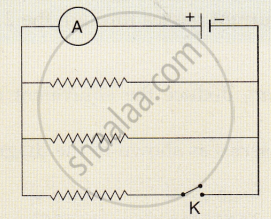Advertisements
Advertisements
Question
Two resistors of resistance 4 Ω and 6 Ω are connected in parallel to a cell to draw 0.5 A current from the cell.
Calculate current in each resistor.
Solution
Equivalent resistance of the circuit:
`1/"R" = 1/4 + 1/6 = (3+2)/12 = 5/12`
`therefore "R" = 12/5 = 2.4 Omega`
Hence, the emf of the cell is
V = IR
∴ V = 0.5 × 2.4
∴ V = 1.2 V
Therefore, current through each resistor is
`"I"_4 = "V"/"R"_4 = 1.2/4 = 0.3 "A"`
`"I"_6 = "V"/"R"_6 = 1.2/6 = 0.2 "A"`
APPEARS IN
RELATED QUESTIONS
Complete the following :-
(c)

An electric heater which is connected to a 220 V supply line has two resistance coils A and B of 24 Ω resistance each. These coils can be used separately (one at a time), in series or in parallel. Calculate the current drawn when:
(a) only one coil A is used.
(b) coils A and B are used in series.
(c) coils A and B are uses in parallel.
In the diagram shown below, the cell and the ammeter both have negligible resistance. The resistor are identical.
A resistor of 8 ohms is connected in parallel with another resistor X. The resultant resistance of the combination is 4.8 ohms. What is the value of the resistor X?
Four resistors each of resistance 2Ω are connected in parallel. What is the effective resistance?
A uniform wire with a resistance of 27 Ω is divided into three equal pieces and then they are joined in parallel. Find the equivalent resistance of the parallel combination.
State the S.I. unit of electrical resistance and define it.
How does the resistance of a metallic wire depend on the thickness of wire?
The least resistance obtained by using 2 Ω, 4 Ω, 1 Ω and 100 Ω is:
A coil in the heater consumes power P on passing current. If it is cut into halves and joined in parallel, it will consume power:
